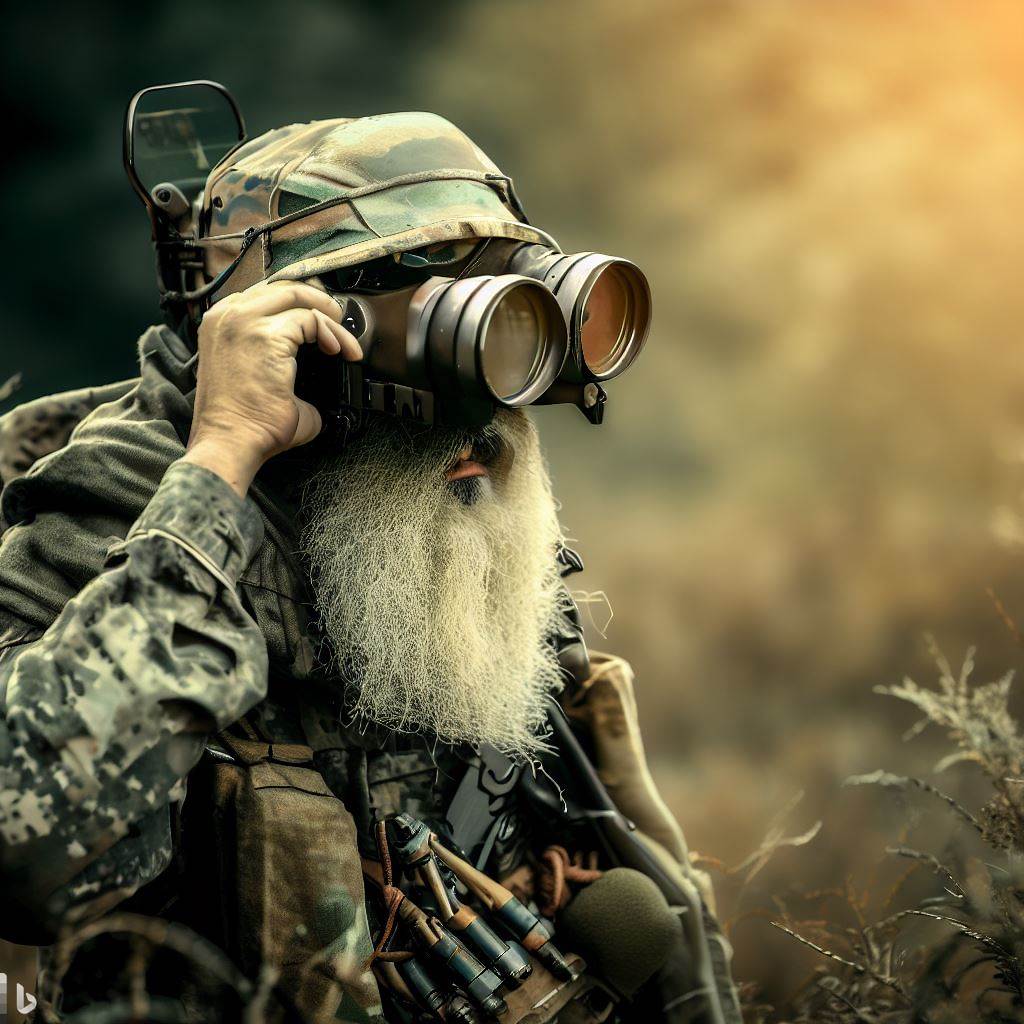

In the quest to enhance our hunting skills and embrace technology, many traditional hunters wonder about transitioning to using military night vision gear for animals. With the advancement of technology, night vision gear has become increasingly accessible to civilians, offering a new perspective on hunting.
This article explores the process of transitioning from traditional hunting methods to utilizing military-grade night vision gear, providing insights and tips on how to make this exciting leap and elevate your hunting experience. So, if you’ve ever wondered how to best incorporate night vision gear into your hunting adventures, keep reading for some valuable guidance.
Understanding The Need For Transitioning
Benefits Of Using Military Night Vision Gear For Hunting
Transitioning from traditional hunting methods to using military night vision gear can offer numerous benefits. One of the main advantages is the enhanced visibility and clarity that night vision gear provides in low-light conditions. With the ability to see clearly in the dark, hunters gain a significant advantage over their prey, improving their chances of a successful hunt.
Additionally, using night vision gear can extend hunting hours. Unlike traditional hunting, which is mostly limited to daylight, night vision gear allows hunters to venture into the darkness when animals are more active. This opens up a whole new world of opportunities for hunters, enabling them to pursue nocturnal animals and increase their chances of a rewarding hunting experience.
Challenges Of Traditional Hunting
Traditional hunting methods have their limitations, particularly in low-light conditions. Without the aid of night vision gear, hunters heavily rely on their natural senses, which are significantly compromised in the dark. This can lead to missed opportunities, unsuccessful hunts, and frustration.
Moreover, traditional hunters are often restricted to specific hunting hours and may have limited access to certain species that are more active during nighttime. This can limit their hunting experiences and the range of animals they can pursue.
Advantages Of Transitioning To Night Vision Gear
Transitioning to night vision gear can overcome the challenges of traditional hunting and offer numerous advantages. By equipping oneself with night vision gear, hunters gain a significant edge in low-light environments. The ability to see clearly in the dark enhances situational awareness, allowing hunters to spot animals and assess their surroundings effectively.
Moreover, night vision gear extends hunting hours, providing hunters with the flexibility to venture out during the night when many animals are more active. With this added advantage, hunters can diversify their hunting experiences and target species that are exclusive to nighttime activities.
Choosing The Right Night Vision Gear


Types of Night Vision Devices
When transitioning to night vision gear, it is important to understand the different types of night vision devices available. Some commonly used night vision devices include goggles, monoculars, binoculars, and scopes.
Night vision goggles are worn like a regular pair of goggles and provide a hands-free experience while offering enhanced vision in the dark. Monoculars, on the other hand, are single-eye devices that provide night vision capabilities.
They are compact and lightweight, making them a popular choice among hunters. Binoculars with night vision combine the benefits of both binoculars and night vision technology, allowing hunters to observe and identify animals more effectively.
Night vision scopes are specifically designed to be mounted on firearms, enabling hunters to accurately aim and shoot their targets in low-light conditions. These scopes offer a seamless integration of night vision technology with the hunting experience.
Factors To Consider When Selecting Night Vision Gear
When choosing the right night vision gear, several factors need to be considered. One crucial aspect is the intended use of the gear. Different devices cater to specific hunting scenarios, such as long-range shooting or close-range observation. Assessing one’s hunting preferences and requirements will help determine the appropriate type of night vision gear.
Another important consideration is the generation of night vision technology. Night vision devices are categorized into generations, with each generation offering varying levels of performance and price points. Understanding the differences between generations and their respective capabilities will aid in selecting the right gear that aligns with one’s budget and expectations.
Other factors to consider include the reliability, durability, and waterproofing of the night vision gear. It is essential to invest in high-quality gear that can withstand the rigors of hunting and adverse weather conditions.
Getting Familiar with Night Vision Technology
How Night Vision Works
To effectively transition to night vision gear, understanding how night vision technology works is crucial. Night vision devices are designed to amplify existing ambient light, such as moonlight or starlight when the available light is minimal.
The functioning of night vision devices can be broken down into four main steps: gathering light, amplification, conversion to visible images, and display. First, a photodetector within the device collects photons of light and converts them into electrons.
These electrons are then amplified through a process called “electron cascading,” resulting in a higher concentration of electrons. The amplified electrons are then converted back into visible light, and the images are displayed on the device’s screen or through the eyepiece.
Understanding Different Generations Of Night Vision
Night vision devices are classified into different generations based on the level of technology employed. Generally, there are four generations of night vision technology, with each subsequent generation offering improved performance and capabilities.
First-generation night vision devices are the most common and affordable. They provide an entry-level experience and are suitable for general hunting purposes. Second-generation devices offer enhanced performance, clarity, and range, making them ideal for more demanding hunting scenarios.
Third-generation devices further improve image quality and are widely used by professionals. Fourth-generation devices incorporate advanced technology, such as gated filmless technology, providing exceptional performance even in extremely low-light conditions.
Understanding the differences between generations will help hunters make informed decisions regarding the night vision gear that best suits their specific needs and budget.
Learning How To Use Night Vision Gear
Proper Handling And Maintenance
Once equipped with night vision gear, it is essential to learn proper handling and maintenance techniques to ensure optimal performance and longevity of the equipment. Each night vision device comes with its specific set of instructions and guidelines, which should be followed meticulously.
Properly handling night vision gear involves avoiding exposure to bright lights, as this can cause damage to the device’s internals. Additionally, it is crucial to keep the lenses clean and free from debris, as any obstruction can negatively impact visibility. Regularly inspecting the gear for any signs of wear and tear and addressing them promptly will help prolong its lifespan.
Training and Practice for Effective Usage
Using night vision gear effectively requires practice and familiarity with the device. Familiarizing oneself with the controls, adjustments, and settings of the device is crucial for a smooth hunting experience.
Engaging in training programs specifically designed for night vision gear usage can be immensely beneficial. These programs provide hands-on experience and guidance on optimizing the performance of the equipment. Additionally, practicing in different hunting scenarios and conditions will help develop the necessary skills to effectively use night vision gear.
Navigating Legal And Ethical Considerations
Laws And Regulations Surrounding Night Vision For Hunting
Before embarking on nighttime hunts using military night vision gear, it is essential to acquaint oneself with the laws and regulations governing the use of such equipment. Night vision gear may have specific restrictions and requirements, varying from region to region.
Researching and understanding these laws will ensure that hunters remain compliant and avoid any legal repercussions. It is advisable to consult local wildlife authorities or hunting organizations for accurate and up-to-date information regarding the use of night vision gear for hunting purposes.
Ethical Responsibilities And Considerations
Beyond legal considerations, transitioning to night vision gear also brings ethical responsibilities. Hunters must prioritize the welfare of both the animals they hunt and the environment in which they operate.
Responsible hunters using night vision gear should strive to maintain fair chase principles, ensuring a level playing field between hunter and prey. This involves refraining from exploiting the enhanced capabilities of night vision gear to gain an unfair advantage over the animals.
Additionally, hunters should adhere to strict hunting limits and regulations to promote sustainable hunting practices and conserve wildlife populations.
Preparing For Night Hunts
Researching Hunting Areas
Proper preparation is vital for successful night hunts. Researching hunting areas beforehand can significantly enhance the hunting experience. Identifying areas with high wildlife activity during nighttime through resources like local hunting guides, wildlife biologists, or online databases will help hunters pinpoint the best locations to focus their efforts.
Understanding the specific habits, preferences, and territories of nocturnal animals in the designated hunting areas is also essential. This knowledge enables hunters to strategize and adapt their approaches accordingly, increasing their chances of encountering the desired species.
Scouting Techniques For Nighttime Hunts
Scouting during the daytime using traditional hunting methods may not provide accurate insights into nocturnal animal behavior. Therefore, transitioning to night vision gear necessitates adopting suitable scouting techniques for nighttime hunts.
Utilizing trail cameras with night vision capabilities can be an effective scouting tool. These cameras capture images or videos when triggered by movement, allowing hunters to monitor wildlife activity in their selected hunting areas. Scouting at dusk or dawn, when nocturnal animals are active, can also provide valuable information about their behavior and patterns.
Enhancing Skills and Techniques
Adapting Hunting Strategies To Night Vision
Transitioning from traditional hunting to using night vision gear requires adapting hunting strategies to maximize the advantages offered by the technology. One crucial aspect is adjusting hunting techniques to account for improved visibility and range in low-light conditions.
Hunters must familiarize themselves with the optimal distance for effective engagement and adjust their shooting techniques accordingly. Stealth and patience are key when using night vision gear. Animals may be more alert during nighttime, necessitating hunters to engage in quieter and more calculated movements.
Mastering Stealth And Surveillance Techniques
Night vision gear enhances a hunter’s ability to spot animals in low-light environments, but it also requires mastering stealth and surveillance techniques to remain undetected. Animals possess acute senses, and any sudden movement, noise, or scent can alert them to the presence of a hunter.
Learning techniques such as slow and deliberate movement, minimizing noise, and remaining downwind of the targeted animals are essential for remaining undetected. Additionally, understanding animal behavior and learning to read their body language can provide valuable clues for successful hunts.
Managing Safety And Security
Protecting Yourself And Others During Night Hunts
Transitioning to night vision gear introduces additional safety considerations that hunters must be mindful of. Safety should always be a top priority to ensure a secure hunting experience for oneself and others involved.
Hunters should inform someone about their intentions and whereabouts before going on nighttime hunts and establish reliable communication methods. Wearing proper protective gear, such as night vision goggles or masks, helps protect the eyes and face from potential hazards.
Carrying a first aid kit and knowing basic first aid procedures is also crucial in case of emergencies.
Preventing Accidental Injuries And Mishaps
Using night vision gear can be an exciting and rewarding experience, but it also requires caution to prevent accidental injuries and mishaps. During nighttime hunts, hunters may encounter hazardous terrain, such as uneven ground or obstacles that may not be readily visible.
It is essential to navigate these areas cautiously and use additional lighting sources, such as headlamps or flashlights, when necessary.
Additionally, practicing proper firearm safety is of utmost importance. Hunters should ensure they are well-trained in firearm handling, maintain proper muzzle control, and follow all safety protocols. Regularly inspecting and maintaining firearms will help prevent malfunctions and ensure safe hunting practices.
Understanding Animal Behavior at Night
How Animals Behave In Low-Light Environments
Nocturnal animals have evolved to thrive in low-light environments, exhibiting unique behaviors and adaptations that allow them to navigate in the dark. Understanding how animals behave at night is crucial for successful nighttime hunts.
Many nocturnal animals have highly developed senses of hearing and smell, compensating for their limited visibility. They rely on these senses to become aware of potential threats or prey. Hunters should take this into account and employ strategies that minimize noise and scent to avoid alerting their targets.
Recognizing Typical Nocturnal Patterns
Nocturnal animals often exhibit typical patterns and routines, which can be discerned through observation and research. Learning about the feeding, mating, and migration habits of nocturnal animals allows hunters to anticipate their movements and increase the likelihood of successful encounters.
Mapping out the movements of nocturnal animals through the use of scouting techniques and trail cameras can provide valuable insight into their patterns. With this knowledge, hunters can strategically position themselves in areas likely to intersect the animals’ routes, improving their chances of sighting and harvesting.
Impact On Conservation And Wildlife Management
Contributing To Conservation Efforts
Transitioning to using military night vision gear for hunting can play a positive role in conservation efforts. Nighttime hunts can target invasive or overpopulated species, helping maintain the balance of ecosystems.
By using night vision gear to specifically target these species during their active hours, hunters can contribute to controlling their populations and promoting the health of native wildlife and habitats.
Additionally, responsible hunters who use night vision gear actively contribute to wildlife management programs. By adhering to established hunting limits, reporting their harvests, and participating in conservation initiatives, hunters help ensure the sustainable use of wildlife resources for future generations to enjoy.
Balancing Hunting And Conservation Goals
Balancing hunting and conservation goals is crucial when transitioning to night vision gear for hunting. Hunters must prioritize conservation by complying with hunting regulations, respecting wildlife habitats, and adopting ethical hunting practices.
By promoting sustainable hunting, hunters can actively participate in conservation efforts while enjoying the benefits that night vision gear provides.
In conclusion, transitioning from traditional hunting methods to using military night vision gear for animals offers numerous benefits. The enhanced visibility and extended hunting hours provided by night vision gear overcome the limitations of traditional hunting, opening up new opportunities for hunters.
Selecting the right night vision gear, understanding its technology, and acquiring the necessary skills through training and practice are important steps in making a successful transition. Adhering to legal and ethical considerations, properly preparing for night hunts, and mastering safety measures contribute to a secure and responsible hunting experience.
Furthermore, understanding animal behavior at night and contributing to conservation efforts foster a balanced approach to hunting. By embracing night vision gear and adapting hunting strategies, hunters can embark on exciting nighttime adventures while respecting wildlife and nature.
The Ultimate Guide to the Top 5 Night Vision Binoculars for Hunting
Top 5 Night Vision Monoculars for Hunting in 2023 | Best Rating
How Do I Minimize Noise When Using Night Vision For Hunting?





